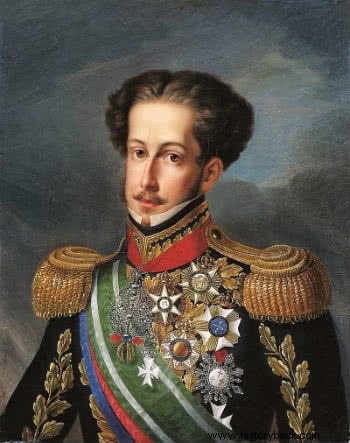Dom Pedro I or Pedro I of Brazil was the first Emperor of Brazil who ruled during the period 1822 and 1831.
It was he who declared the Independence of Brazil on September 7, 1822 and granted the first Constitution in 1824.
Biography
 Portrait of Dom Pedro I by Simplício Rodrigues de Sá (1830)
Portrait of Dom Pedro I by Simplício Rodrigues de Sá (1830)
Pedro I was born in Queluz (Lisbon District), Portugal, on October 12, 1798. He was the son of Dom João VI of Portugal and Infanta Carlota Joaquina of Spain.
Dom Pedro I's full name was Pedro de Alcântara Francisco Antônio João Carlos Xavier de Paula Miguel Rafael Joaquim José Gonzaga Pascoal Cipriano Serafim de Bragança e Bourbon.
He remained in Portugal during his childhood at the Palace of Queluz. There he had a good education with classes in arts, letters and languages.
In 1808, when he was just 9 years old, he and his family moved to Brazil and began to live at Quinta da Boa Vista, in Rio de Janeiro.
The royal family left the country due to the French Napoleonic invasions that took place from 1807 onwards.
In 1817, Dom Pedro I married Maria Leopoldina Josefa Carolina de Habsburgo, Archduchess of Austria, daughter of the Emperor of Austria.
With her he had six children:Maria da Glória, Miguel, João Carlos, Januária, Paula, Francisca and Pedro de Alcântara.
In 1820, his father returned to Portugal because of the Liberal Revolution in Porto. Meanwhile, Pedro remains in Brazil as Prince Regent, appointed on April 22, 1821.
The Portuguese Crown sent a message for Dom Pedro I to return to Portugal; and also mentions Brazil's intention to return to being a colony.
By refusing to return to the metropolis (Portugal), on January 9, 1822, he declares:
“If it is for the good of all and the general happiness of the nation, tell the people that I stay ”.
This moment became known in Brazilian history as the “Dia do Fico”. This factor made the Portuguese Court very uncomfortable, which sent a letter of retaliation, at the same time suspending the payment of its earnings.
Consequently, he was responsible for the political independence of Brazil that took place on September 7, 1822. He participated in the Confederation of Ecuador and the Cisplatine War.
The First Reign (1822-1831) began with the Independence of Brazil. Dom Pedro's government was centralizing and authoritarian. Brazil was going through several difficulties and, therefore, the discontent of the population grew more and more.
In 1826 he became the widower of his first wife, and in 1829 he remarried Amelia Augusta Eugenia Napoleon of Leuchtemberg, a German duchess. With her he had a daughter:Maria Amélia.
He had an extramarital relationship with Domitila de Castro Canto e Melo (Marquesa de Santos) and with her he had five children, three of whom died prematurely.
He died in his hometown on September 24, 1834, a victim of tuberculosis.
In 1972, on the 150th anniversary of Brazil's independence, the remains of Dom Pedro I were brought to the crypt of the Ipiranga Monument in São Paulo.
Abdication of Dom Pedro I
When his father died in 1826, Dom Pedro I was named Monarch of Portugal. But he abdicated the crown and in his place was his eldest daughter Maria da Glória (who would be Queen Maria II), who was only 7 years old.
However, Miguel, the eldest brother of Dom Pedro I, claimed the throne from his niece.
With several problems to solve in the colony and in the metropolis, Dom Pedro I abdicates the throne of Emperor of Brazil on April 7, 1831.
In his place remained his youngest son, Pedro de Alcântara, who would ascend to the throne as Dom Pedro II, who at the time was 5 years old.
After leaving the position of Emperor of Brazil, he returns to Portugal with the title of Duke of Bragança. His aim was to assist his daughter with taking the throne.
The throne that had been usurped by his brother, Dom Miguel, generated a civil war in the country.
This war lasted more than 2 years and presented a struggle between defenders of liberalism and, on the other hand, those defending absolutism.
Shortly afterwards, Dom Pedro contracted tuberculosis, a fatal disease at the time. Because of this, he dies in the Queluz Palace at the age of 36.
Did You Know?
Dom Pedro I was the 27th King of Portugal, with the title of Pedro IV.
Given the importance of Dom Pedro I for the history of Brazil, there are several avenues, institutes, schools and shopping centers named after the Emperor.
Also read:
Independence of Brazil
Causes of Brazil's Independence
